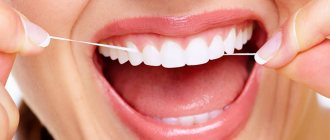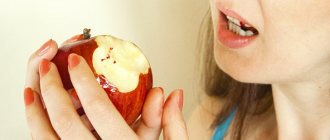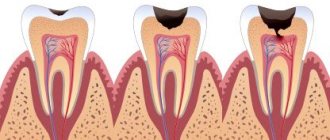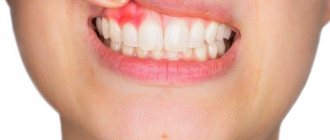The discomfort that occurs next to an interlocutor who has a problem with bad breath is familiar to everyone. The prevalence of this disease is extremely high: more than half of the world's population. Some clinical studies report a prevalence of 60% and even 80%. It would be a good reason to ignore the problem, because these are the majority! However, independent surveys have shown that almost 50% of respondents claim that bad breath significantly harms the successful career of its owner (especially if the professional activity is related to communication). 20% of respondents consider halitosis one of the most repulsive physiological “manifestations” of a human person (surveys were conducted in the UK). A person who has the problem of halitosis often does not even realize it, because he is adapted to his own smell. Humans, like other living beings, are evolutionarily programmed to pay attention primarily to unfamiliar, pungent and unpleasant odors. The sense of smell allows living beings to find food, find a sexual partner, receive sensory pleasure (for example, the smell of flowers or perfume), and also receive alarm signals (for example, spoiled food, dangerous chemicals). Knowing about the problem of bad breath, patients, as a rule, try to solve the problem on their own, turning to perfume, refreshing rinses, sprays, chewing gum, etc. However, these techniques only mask the unpleasant odor for a short period. A real solution to the problem can be achieved with the help of a specialist who will competently identify the causes of halitosis and select adequate treatment.
Classification and diagnosis
The diagnosis of this disease should be carried out by a dentist; if no causes are found on this side, then it is necessary to undergo an examination by a therapist.
There are several types of halitosis:
- Physiological – in the absence of pathology, and the smell is the result of the accumulation of bacteria or plaque.
- Pathological, which is caused by diseases (diabetes, cirrhosis of the liver, internal bleeding, etc.).
- Pseudogynosis is a slight odor that is not perceived by others, but the patient often complains.
- Hapitophobia – occurs after treatment or examination. When no pathologies are found, there is no smell, but the patient continues to insist that there is an unpleasant odor.
The latter option refers to psychosomatic disorders and in this situation it is necessary to undergo a course of psychotherapy. It is also important to understand that the problem may be systemic and will require treatment from several specialists at once.
Your mouth is under attack from germs!
Where does the unpleasant smell come from? Various microorganisms live in the nasopharynx and oral cavity; the list of them is quite impressive - more than 120 species. These microbes “nest” in pathological gum pockets, carious cavities, interdental spaces, nasopharyngeal mucus, secluded places in the tonsils and other “quiet pools.” This fact alone indicates that only careful and competent hygiene of the oral cavity (and the entire digestive tract along with the respiratory system) can control the situation with microbial “revelry”.
Causes
The causes of halitosis can be internal and external. Among them, the main ones include:
- Improper oral hygiene, especially when wearing braces and orthodontic structures;
- Presence of dental plaque and harder deposits;
- Caries of any depth of lesion;
- Constant or frequent dry mouth (due to stress or lack of fluid) leads to disruption of the microflora;
- Dental diseases of infectious, bacteriological and inflammatory nature;
- Poor nutrition: excessive consumption of sweets, spicy foods, alcohol, salty foods, protein diet and smoking;
- Complications of the dental field – pericoronitis, peri-implantitis, alveolitis;
- Diseases of the respiratory tract, digestive, genitourinary, endocrine systems;
- Taking medications that change the composition of saliva.
In a situation where there are no external dental causes, it is necessary to consult a therapist to identify the underlying disease that provokes a change in bad breath.
How to get rid of halitosis
1. You can restore fresh breath with medications. Popular remedies for halitosis are anti-inflammatory and antibacterial drugs. Serious diseases are treated with potent tablets, but halitosis is not one of them. You can get rid of it in safer ways.
2. Start with hygiene. Brush your teeth for at least 2 minutes twice a day. There are special antihalitosis toothpastes that contain additives with antimicrobial effects. Therapeutic and prophylactic agents restore the microflora, relieving the mucous membrane of dryness.
Symptoms
If an unpleasant odor appears only in the morning and goes away after hygiene procedures, then this is the physiological nature of the occurrence of halitosis. This condition is considered normal and does not require any intervention other than regular hygienic cleaning. Attention should be paid to the chronic nature of the odor, which is most often accompanied by the following symptoms:
- Increased sensitivity, looseness and bleeding of gums;
- Tooth mobility and the presence of gum pockets;
- Plaque on the mucous membranes of the mouth;
- Darkening of the enamel along the gum ;
- Pain and swelling of the mucous membranes of the tongue.
In the absence of these symptoms, we can talk about an atypical manifestation and it is necessary to exclude the presence of internal diseases.
Causes of halitosis
- poor quality daily brushing of teeth and gums;
- the presence of plaque on the teeth, lack of hygienic brushing of teeth for a long time;
- chronic ENT diseases;
- development of caries;
- gum disease;
- human speech activity;
- imperfect tongue cleaning;
- eating spicy foods;
- diseases of internal organs and systemic pathologies (diabetes, gastrointestinal disorders);
- stressful conditions;
- alcohol consumption;
- caffeine abuse;
- use of strong medications;
- incorrect prosthetics, against the background of which pathogenic bacteria accumulate under prosthetic structures.
Halitosis is called a speaker's disease. People whose profession involves continuous speech activity and who have dental problems are very often diagnosed with halitosis.
Halitosis: treatment
The main treatment for halitosis comes down to professional teeth cleaning, when soft and hard plaque is removed. After this, the cause of the unpleasant odor is identified, and a treatment regimen is developed.
Halitosis involves treatment in adults by eliminating caries, inflammation of the mucous membranes, and removing teeth that cannot be restored. Drug treatment is carried out by an orthodontist; in situations where there are carious cavities or appointments for tooth , the person is redirected to another therapist. If halitosis is detected in a child , then the reason is most often due to improper hygiene, and accordingly it will be important to teach proper hygiene and treat possible caries. At any age, the mandatory stages of treatment will be:
- Correction of nutrition - avoidance of foods that can cause an unpleasant odor or contribute to the spread of bacteria;
- Oral hygiene : choosing a toothbrush and toothpaste, teaching hygiene using dental floss and brushes, and choosing a mouthwash.
- Antiseptic care to reduce bacteria if halitosis is associated with the development of pathogenic flora.
- Treatment of infectious gum diseases using applications of ointments and gels.
In situations where halitosis is caused by orthodontic and orthopedic structures, it is necessary, together with your doctor, to choose an alternative treatment method or select effective products . If the cause of bad breath is other systemic diseases of the body, then treatment should begin with them. For example, consult an endocrinologist or gastroenterologist, because Until the cause is eliminated, dental prophylaxis will be useless.
Do you talk a lot? Beware of halitosis
More often than others, halitosis affects workers of the so-called “conversational” genre - public politicians, lecturers, lawyers, radio show hosts... This happens due to the fact that during a conversation the oral cavity “dries out”, and active movements of the tongue help to “extract” the unpleasant odor from the most deeply hidden habitats of microbes. As you understand, in this case, neither candy nor chewing gum are helpful: diction suffers from them. And it’s not nice to chew or suck a pill during a performance. In this case, a traditional decanter of regular or mineral water will help.
Halitosis: treatment at home
Halitosis can be treated with traditional methods at home, but all procedures should be carried out after consultation with a doctor , and in the absence of serious health pathologies. The main direction of treatment is to remove pathogenic microflora. To do this, use herbal rinses:
- Chamomile;
- Oak bark;
- Sage.
Infusions should be warm, because... hot broth can burn your mouth and provoke the development of the disease. If fresh breath disappears due to hygiene or nutrition, then it is recommended to eat apples, carrots and pears, which gently remove plaque and massage the gums. Fresh herbs (parsley, mint, rosemary, basil) freshen your breath. Ginger root, which is finely chopped and consumed after meals, also helps well. It is important to make sure that you are not allergic to them before consuming any food.
Patient complaints about bad breath (so-called halitosis) are well known. The main cause of halitosis is an increase in the concentration of volatile sulfur compounds (VSCs), which are formed in the oral cavity as a result of the enzymatic breakdown of protein by local microflora under alkaline conditions. Most oral bacteria, with the help of their enzymes, take part in the destruction of proteins and the formation of VSCs from sulfur-containing amino acids. Excessive numbers of bacteria are caused by chronic inflammatory processes in soft tissues, for the treatment of which the use of rinses is recommended [1-3, 19]. It has been proven that rinses containing essential oils (EOs) provide renewal of the normal microflora of the oral cavity [4-6]. They cause the dissolution of the cell wall of bacteria that form dental plaque or biofilm [7, 8], as they inhibit their enzymatic activity [9, 10]. EO components form bonds with the bacteria of the initial layers of the biofilm (mainly with gram-positive species of microorganisms), slowing down the process of their division, as well as inactivating endotoxins released during the destruction of gram-negative pathogenic bacteria [11, 21]. EOs are liquid oily mixtures of organic substances produced by plants and responsible for their smell. More than 1000 different compounds have been isolated from EOs, among which monoterpenoids and sesquiterpenoids, alcohols, acids, aldehydes, ketones, oxides, peroxides, lactones, their fairly common aromatic compounds, and less often heterocyclic compounds predominate.
About 3000 EOs are known, of which about 300 are practically used. EOs are colorless or light yellow, less often liquids colored in other colors, for example, EOs from chamomile flowers are blue. Most EOs are found in plants growing in arid tropical and subtropical areas. The composition of essential oils, and with it the smell, change depending on the phase of plant growth, natural and agrotechnical factors. In medicine, both the oils themselves and the components isolated from them are used: camphor, menthol, cineol, linalool, thymol, geraniol, citral, etc.
Raw materials containing essential oils are used to stimulate appetite and secretion of gastric juice, activate diuresis, and also as analgesics, antibacterial and nervous system regulators that provide stimulating, stimulating or calming effects. EOs and their components are also used to improve the smell of medicines; they are widely used in the food industry for the preparation of drinks and canned food, in the perfume industry and in households as both flavoring additives and for flavoring drinks. EOs are contained in the root of valerian, the rhizome of calamus and ginger, the leaves of peppermint, eucalyptus, clary sage, the flowers of chamomile, lavender and arnica, the buds of pine, birch and aspen, the fruits of fennel and anise, in the herbs of thyme, thyme, yarrow, wormwood, as well as in the peel of citrus fruits.
One of the most important medicinal properties of EOs is their antimicrobial effect [12], the spectrum of which is wide and different in different plant species. Depending on the chemical composition and concentration of the substances that make up the EO, as well as on the duration of exposure to microorganisms, the result of this exposure can be both bacteriostatic and bactericidal. The impact of EM on a microorganism mainly consists of the destruction of the cytoplasmic membrane with a subsequent change in metabolic processes in the microbial cell and disruption of aerobic respiration. It is important to note that, being in prolonged contact with EOs, microorganisms do not become resistant to them, and new resistant strains are not formed. The ability of EOs to enhance the effect of chemotherapeutic, synthetic antiseptics, as well as antibiotics has been established. In addition, their anti-inflammatory properties determine the protection of body cells from damage, weaken the exudative process, increase the infiltration of leukocytes and microphages, and enhance cell proliferation. This is partly due to the antioxidant effect inherent in individual substances that make up the EO, as well as the ability to inhibit reactions caused by free radicals that destroy healthy cells of the macroorganism. As a result, cell membranes are stabilized and capillary permeability decreases. At the same time, the phagocytic activity of macrophages and leukocytes increases. Observations have shown that the correctly selected combination of essential oils in drugs enhances their antibacterial effectiveness. It is known that EOs have a stronger effect on coccal microflora (staphylococci, streptococci, etc.). EOs contained in the leaves of sage and eucalyptus, thyme, yarrow, wormwood and chamomile flowers have a particularly active therapeutic effect. For the treatment of oral diseases, the most suitable types of medicinal raw materials are calamus rhizome, oak bark, peppermint leaves, clary sage, eucalyptus, strawberry, thyme, thyme, yarrow, wormwood, St. John's wort, arnica and chamomile flowers [18] . In dentistry, medicinal plants containing flavonoids along with essential oils are widely used. Flavonoids are phenolic substances that are found in almost all above-ground parts of plants: leaves, buds, flowers, fruits. They are contained in cell sap and determine the color of flowers, leaves, fruits and roots. Plants contain predominantly flavonoid glycosides, which are highly soluble in water, are non-toxic and provide numerous pharmacological effects: antibiotic, anti-inflammatory, choleretic, diuretic, wound healing and hepatoprotective. Bioflavonoids (BP), which are flavonoids with the inherent action of vitamin P, are essential. They reduce the permeability of blood vessels and prevent capillary fragility, and therefore their use in the treatment of chronic inflammation is recommended: BPs also have antioxidant properties, binding free radicals that destroy cellular structures. In addition, plant-based dietary supplements stimulate a more complete use of vitamin C in the body.
Tannins (TS) perform a special function in the treatment of pathological processes in the oral cavity. DVs, or tannides, are high molecular weight polyphenols that are highly soluble in water. An astringent effect in the mouth is characteristic to a greater or lesser extent when using all tanning plants. DV are contained in various pathological growths of leaves (galls), roots, rhizomes, bark, leaves of plants, differing quantitatively depending on the type and phase of plant development, climate and other environmental factors. Tannin is obtained industrially from some types of galls. Medicinal herbal remedies containing DV form a dense film of albuminates on the mucous membrane, stop bleeding, have an antibacterial and anti-inflammatory effect, without being introduced or absorbed into the cell. The feeling of constriction of the mucous membrane is caused by the dissolution of DV in water, a change in the protein-colloidal state in the tissues, as a result of which they turn into insoluble compounds (proteins coagulate). DV, getting on the mucous membranes or wound surface, form a thin but dense protective layer - an insoluble film (water-insoluble compounds with CONH bridges). With inflammation of the soft tissues of the oral cavity, the protein content locally increases significantly. When treating the surface of the inflammatory focus with a product containing DV, further spread of the inflammatory process is interrupted and local bleeding stops. Raw materials and preparations containing active substances are most often used externally as astringents and bactericidal agents for inflammation of the oral cavity (gums), respiratory tract, and also in the treatment of burns. In dental practice, the following types of medicinal plant materials containing DV are used: oak bark, alder fruit, serpentine rhizome, bergenia, cinquefoil, St. John's wort herb in the form of an infusion or decoction [13-17].
For halitosis, natural substances are used that differ in composition and action. Most of these products contain EOs in combination with other active substances - flavonoids, polyphenols, triterpenes, polysaccharides, organic acids, vitamins, minerals, etc. For the treatment of halitosis, it is useful to use chamomile flowers, which contain up to 1% blue EOs and which include: chamazulene, bisabol and its oxides, as well as polyines. In addition, chamomile flowers contain a significant amount of flavonoid glycosides - quercetin, kaempferol, apigenin, as well as phenol carbonic acids, polysaccharides, carotenes, organic acids, vitamins B and C, minerals - selenium, zinc and copper. A wide variety of biologically active substances determines the variety of medicinal properties of chamomile flowers: anti-inflammatory, antiseptic, antiviral, antispasmodic and emollient.
Thyme herb, which contains up to 1% EO, has a particularly strong antimicrobial effect. The main components of this essential oil are phenols - thymol and carvacrol with a pronounced bactericidal effect. In addition, the EO composition of thyme herb includes p-cymene, caryophyllene, linalool, borneol and other terpenoids. Thyme herb also contains various flavonoids, triterpene acids - oleanolic and ursolic, caffeic acid, chlorogenic acid, DV, as well as minerals: selenium, iron, molybdenum. The complex of these substances determines the bactericidal, anti-inflammatory and antispasmodic activity of an aqueous infusion of thyme herb, used in a 1:1 ratio with chamomile flowers. This mixture enhances the healing effect. Aqueous extracts and decoctions from a mixture of raw materials are prepared and used at home. Studies have shown that these remedies are effective not only for halitosis, but also for inflammation of the gums and oral mucosa.
Material and methods
The study included 215 people (149 women and 66 men) whose main complaint was bad breath when breathing. The project “Diagnostics of halitosis” was approved by the Central Commission for Medical Ethics of the Ministry of Health of Latvia on August 10, 2000. For objective diagnosis and determination of quantitative criteria, haligrams were used, which were recorded using a portable sulfide monitor or halimeter (“Halimeter”, “Interscan Cooperation”, USA ). The amount of VSC was identified in parts per billion (in ppb - parts per billions).
When calculating the results, a diagnostic haligram and a post-therapy haligram were used. To determine the exact amount of VSC, it is necessary to have high-quality records of haligrams. To determine the area under a curve, mathematics uses various approximate numerical integration methods, which are based on calculating a definite integral over the sum of small areas under the curve. Diagnostic haligrams and haligrams taken after treatment to determine the amount of PVR were specially processed to determine an objective quantitative result (Fig. 1 and 2).
Figure 1. Example of a diagnostic haligram (amount of LSS - in ppb).
Figure 2. Example of a haligram after treatment of halitosis (amount of PVR - in ppb).
We used a computer method for processing graphic images and a computer program (Fractal Dimension 1.1 version) developed at Bar-Ilan University; to obtain data using it, the size and number of pixels contained in a curve or figure were used. Thus, the area of a figure can be estimated as the sum of individual pixels [2]. To determine the area under each haligram curve, a characteristic area is isolated and prepared for data processing (Fig. 3-6).
Figure 3. Black and white image of a copy of a haligram fragment.
Figure 4. Part of a copy of a haligram fragment prepared for data processing.
Figure 5. Part of a copy of a haligram fragment converted to a histogram.
Figure 6. Part of a copy of a haligram fragment with different pixel values. a — the initial appearance of a haligram fragment in the program window; b — pixel size — 1 conventional unit, number of pixels — 21,170; c — pixel size — 5 units, number of pixels — 1123; g — pixel size — 10 units, number of pixels — 331; d — pixel size — 15 units, number of pixels — 188; e - pixel size - 20 units, number of pixels - 123.
The part under the haligram curve is colored, i.e. this haligram was turned into a histogram (Fig. 5)
.
The histogram obtained from the haligram is considered as a complex figure with an area having a fractional dimension. The dimension of a fractal is determined graphically by marking the pixel size on a logarithmic scale on the abscissa axis, and on the ordinate axis the corresponding number of pixels, also on a logarithmic scale. The direction coefficient of the resulting straight line with the opposite sign is the dimension of the fractal (Fig. 7),
Figure 7. Determination of the fractal dimension. which characterizes the complexity of the figure under study. Using the specified computer program, it is found that the dimension of the fractal under study is 1.755.
The haligram was analyzed in a similar way after a course of therapy (Fig. 8).
Figure 8. Part of a copy of a haligram fragment (after treatment) with different pixel values. a — initial view of a haligram fragment (after a course of therapy) in the program window; b — pixel size — one conventional unit, number of pixels — 8263; c — pixel size — 5 units, number of pixels — 438; g — pixel size — 10 units, number of pixels — 156; d — pixel size — 15 units, number of pixels — 106; e - pixel size - 20 units, number of pixels - 51.
Using the mentioned computer program, it was established that the dimension of the studied (after therapy) fractal was 1.566. Thus, the decrease in this fractal was 0.189.
For the treatment of halitosis, a treatment plan was prescribed based on the cause and localization of the inflammatory process. It was recommended for patients of group 1 to use Listerine to rinse the mouth, for patients of group 2 to use an aqueous infusion of chamomile flowers, and for patients of group 3 to use a combined infusion of thyme herb and chamomile flowers in accordance with the instructions [22-24]. Most of the subjects (190 people) chose Listerine for rinsing, and only 25 - infusions of medicinal herbs. Since diagnostic halimetric measurements were relatively similar in all groups of patients, one of the objectives of the study was to determine the effectiveness of the essential oils and polyphenols contained in the herbs used in the treatment of halitosis. All patients were instructed on the preparation of aqueous infusions of medicinal herbs. For statistical analysis of the results, the computer program SPSS for Windows 16.0 (SPSS, USA) was used.
Results and discussion
Initial haligrams showed that the mean halimetric values were 317.53 ppb (SD±126.54).
In Fig. 9
Figure 9. Average age of patients using different rinses. The age composition of patients in all three groups is presented.
The halimetric parameters after rinsing the mouth with Listerine are graphically shown in Fig. 10.
Figure 10. Changes in halimetric parameters after rinsing the mouth with Listerine. There is a relatively wide range of results depending on the age of the patients. In people under 50 years of age, halimetric parameters decreased significantly after therapy - by 200 parts of a billion. The decrease in indicators turned out to be especially significant when their initial values were high.
The dynamics of halimetric parameters in a group of people who rinsed their mouths with an infusion of chamomile flowers is presented in Fig. eleven.
Figure 11. Changes in halimetric parameters after rinsing the mouth with an infusion of chamomile flowers. The decrease in indicators amounted to 40 parts of a billion. Thus, an infusion of chamomile flowers is an effective treatment for halitosis.
A relatively small number of patients, in order to treat halitosis, rinsed the mouth with a combined infusion of chamomile flowers and thyme herb (Fig. 12),
Figure 12. Changes in halimetric parameters after rinsing the mouth with a combined infusion of chamomile flowers and thyme herb. Therefore, in this case there is a large scatter of results. In this group, after therapy, an improvement in halimetric measurements of approximately 40 ppb was achieved.
To compare the effectiveness of different mouth rinses, a 75% improvement was used as a baseline. The improvement in halimetric indicators as a percentage is shown in Fig. 13.
Figure 13. Improvement in halimetric parameters (≥ or <75%) after therapy for halitosis. To clearly demonstrate the effectiveness of various mouth rinses included in the treatment plan for halitosis, a group using a combined infusion of thyme and chamomile flowers was added to the group of people using an infusion of chamomile flowers.
In 91.1% of patients who used Listerine for mouth rinsing, the improvement in halimetric parameters was 75% or more. In the group that used infusions of medicinal plants, only 28% of people showed an improvement of 75%. Thus, Listerine is an effective mouth rinse in the treatment of halitosis, including those with very high initial levels. Improvement in the group of patients who used infusions of medicinal herbs also indicates a positive therapeutic effect.
In Fig. 14
Figure 14. Scheme for improving halimetric performance. treatment results are presented even more clearly. In the case of the use of Listerine, a stable, 80% improvement was observed across different baseline indicators. If the initial values did not exceed 350 parts of a billion, the improvement in the treatment of halitosis with medicinal herbs was approximately 70%, and in the Listerine group - an average of 80%. Thus, infusions of medicinal herbs can be recommended for the treatment of halitosis in cases where the initial halimetric indicators do not exceed 350 parts of a billion.
The effectiveness of herbal rinses containing essential oils and polyphenols is comparable to the effectiveness of Listerine mouth rinse. It should be noted that rinses made from medicinal herbs, in addition, have a pronounced antibacterial effect, while at the same time not causing resistance in microorganisms. Ready-made mouthwashes were mainly used by young people. Only 11.62% of study participants who complained of halitosis expressed a desire to prepare their own herbal rinses. Halimetric indicators of diagnostic haligrams (on average 317.53 parts of a billion) indicated severe halitosis. During treatment, patients in all groups experienced a stable, identical decrease in halimetric parameters.
Preventive actions
Prevention of halitosis is the main and most effective way, because Periodic treatment of this problem does not solve it comprehensively. To avoid bad breath, you must do the following:
- Choose a toothbrush with the appropriate degree of hardness. If you have periodontal disease, then the bristles should be soft; for those who have a tendency to form plaque, it is better to choose harder bristles.
- Use pastes and powders without abrasives to avoid deformation of the enamel.
- Regularly after meals, use brushes or floss to clean your teeth, and a mouthwash with an antibacterial effect.
- Drink plenty of water to prevent dry mouth.
- Reduce the amount of coffee and tea that form plaque, and also stop smoking.
Timely undergo preventive examination not only from the dentist, but also from other specialists. This is necessary for the prevention and treatment of other diseases in which halitosis is only a symptom. Contact us for professional oral hygiene in the clinic.
Bad breath - impairs understanding
Smells play, perhaps, one of the most important roles in our lives, which is very difficult to overestimate - under the influence of one or another smell, many likes and dislikes arise, although often we don’t even think about it. Bad breath (halitosis or halitosis) can thoroughly ruin a person’s life: they won’t hire him, they won’t want to continue getting to know him, work colleagues will try to turn away or move further away during a conversation... Unfortunately, most people are not even aware of the staleness of your breath - a person gets used to his own smell, gets used to it and cannot form an objective opinion about it. Only a few people can make a sensitive request to “test” their own breathing to a friend or loved one. If you suspect that your own breath is “stale”, you can try to do it yourself: take a small cotton swab, apply it to the middle part of your tongue and slightly moisten it. After this, the cotton roll can be assessed for the presence of an unpleasant odor.
Eliminating other causes of unpleasant odor
It is more difficult to get rid of bad breath that is not related to dentistry. If the cause is metabolic disorders, treatment may take a long time. With diabetes, it is important to achieve stable blood glucose levels. Then the ammonia aroma will not bother you. To do this, patients with type 1 disease carefully select the dosage of insulin, and for type 2 diabetes mellitus, they are prescribed a balanced diet and medications to lower blood glucose.
For those with severe kidney problems, the only way to eliminate the smell of urea is to undergo hemodialysis. This is a method of artificial purification of blood plasma, which helps get rid of metabolic products.
Treatment of tonsillitis and respiratory pathologies is carried out with antibiotics. But with the chronic course of the pathology, this is a long process.
The most common cause of bad breath is improper oral care. By visiting the dentist at least once a year and choosing the right brush, paste and floss, you can avoid the onset of halitosis or treat it at an early stage.











